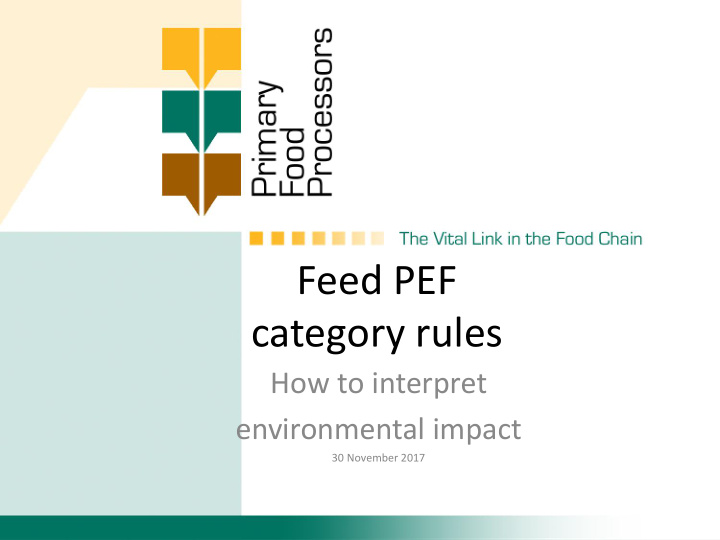



Feed PEF category rules How to interpret environmental impact 30 November 2017
Primary Food Processing (1) • Primary Food Processing (PFP) companies are processing yearly 220 million tons of agricultural raw materials: – Oilseeds and crude vegetable oils – Sugar beets – Starch potatoes and maize – Wheat, rye and oat – Cocoa beans
Primary Food Processing (2) • PFP companies deliver high quality ingredients at large scale and optimized cost. • PFP processing is highly efficient, but in most cases the specific origin of the agricultural raw materials is not available, making it impossible to relate environmental data to those raw materials.
PFP on life cycle assessment • PFP sector organisations and their individual companies invested significantly in environmental life cycle assessment (LCA) and/or product environmental footprints (PEF) of their products. • PFP is welcoming the EU harmonization that PEF brings, provided its use is voluntary. • Environmental LCA and PEF should be used for getting to know the hot- spots of products’ life cycles, but not for product comparison.
Feed PEFCR pilot • The Feed PEFCR pilot is developing rules on product environment footprint of EU compound feed production. • FEDIOL co-sponsoring the Feed PEFCR pilot. • In this pilot FEDIOL is representing the EU feed ingredients production: oilseed meals and vegetable oils.
Feed PEFCR results • Average EU compound feed composition Cereals 48% Oilseed meals 28% Co-products from the food and biofuels 15% industry Minerals, additives 4% Other 5%
Results for four impacts [Feed PEFCR screening report] 100% 90% 80% 12. Transport 70% 11. Energy use feed mill 10. Other 60% 09. Mineral,additives,vitamins 08. Pulses 07. Dried Forages 50% 06. Products of animal origin 05. Vegetable meals 40% 04. Vegetable oils 03. Co-products of the food industry 30% 02. Tapioca 01. Cereals 20% 10% 0% Climate change Climate change ex LUC Particulate matter Acidification
Results of four impacts • Global warming impact of land use change uses twenty years amortization. However, action plans launched by soy operators in South America contributed to sharp decline in deforestation. • Feed ingredients production representing biggest share of the impact of feed.
Hot spots [Feed PEFCR screening report] • Energy use in farming, processing, transport, fertilizer production feed milling steps leading to photochemical smog, particulate matter, climate change, acidification and eutrophication. • Nitrogen in fertilizer leading to eutrophication acidification and climate change • Soy bean growing in South America for land transformation. • Phosphor in fertilizer for eutrophication and resource depletion • Metals in fertilizer and use of pesticides relevant for toxicity related impacts. • Water depletion linked with irrigated crops.
Environmental impact of feed A life cycle for a feed product & 15 more environmental Climate change impacts… PFP I Fertilizers
Function of a feed Climate change PFP I Fertilizers
Climate change per unit raw material Allocation Allocation rule 1 PFP I Fertilizers 40 % Allocation rule 2 50% + 40% = 90% Climate change gap 10% !
Loss of geographical coordinates C 1 F 1 P 1 PFP I C 1 F 1 P 1 Fertilizers C 1 F 1 P 2 C 1 F 2 P 1 C 1 F 1 P 2 C 2 F 1 P 1 C 1 F 2 P 1 C 2 F 1 P 1
Conclusions • PFP appreciates EU harmonization that PEF brings. • Any environmental claim should be PEF compliant, but such claims should remain voluntary. • LCA/PEF good for getting to know environmental hot spots in the life cycle of products. • Activities early in the life cycle often taken a large share of the environmental impact of feed production • LCA/PEF unfit for comparison of environmental performance of intermediary products: – Impact is expressed at product level, not at the level of function. – LCA/PEF results give a picture of the past, not a prediction of the future. – Different markets asking for different types of allocation. – Loss of geographical coordinates triggers use of databases. • Improvements at individual farm level will translate in improved country averages.
LCA work by PFP sectors • Environmental LCA studies by PFP sectors (click on the weblinks) • EU beet sugar from field to factory • Cradle-to-gate study of products from the starch industry • Oilseed processing and vegetable oil refining.
Recommend
More recommend